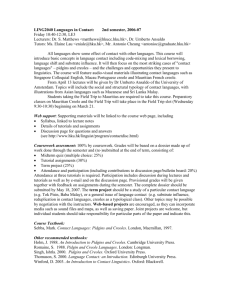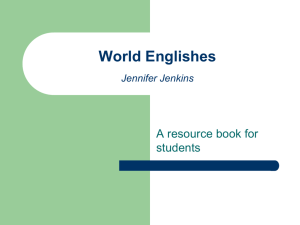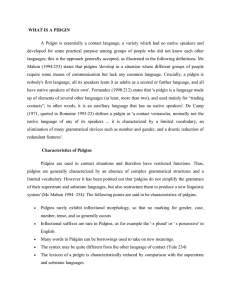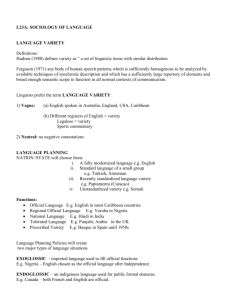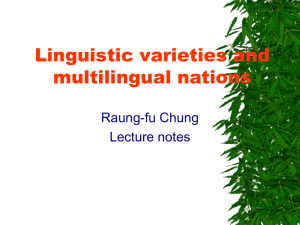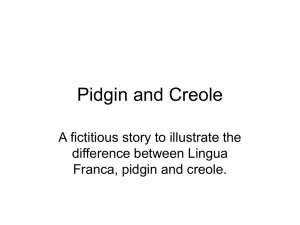LING 122: ENGLISH AS A WORLD LANGUAGE - 18 Language Contact:
advertisement
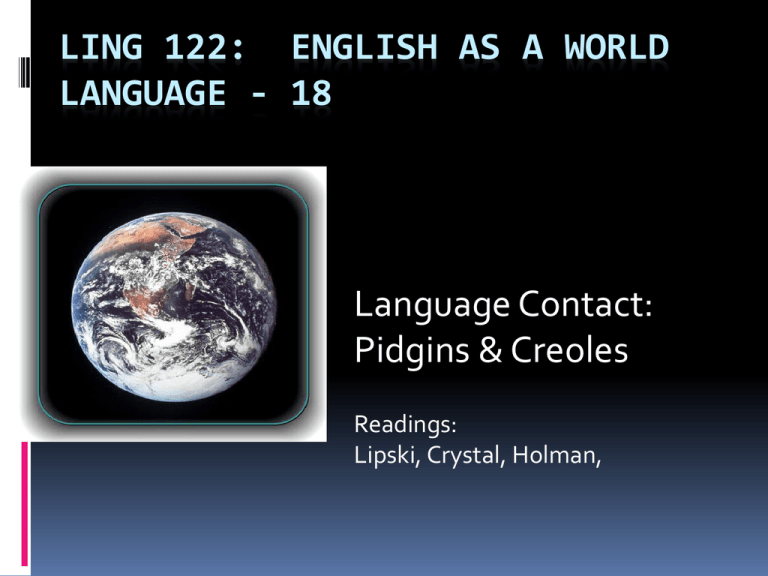
LING 122: ENGLISH AS A WORLD LANGUAGE - 18 Language Contact: Pidgins & Creoles Readings: Lipski, Crystal, Holman, Sample Pidgins & Creoles PIDGINS AND CREOLES - Characteristics and origins of Pidgins and Creoles - Expanded pidgins - Creole origins - From pidgins to creoles -- Hawaiian Creole English - Developments in the UK and the US *Notes based on Jenkins, J. 2003. World Englishes, Routledge, pp. 55-60, 99-106, 154-162. Pidgins Limited functions (esp. trade) No native speakers (nobody’s mother tongue) Contact language involving at least two, often three different language groups That is, it is the product of a multilingual situation in which those who wish to communicate must find or improvise a simple language system that will enable them to do so. Pidgin Origins So Pidgins, in the stereotypical case, are formed when speakers of one language engage in trade with speakers of another, or work on plantations managed by speakers of another, and neither knows the other’s language. In plantation settings, their manual function is to enable workers to communicate with each other, since plantation laborers very often do not speak the same language. Pidgins Very simple languages that develop just linguistically and functionally enough to satisfy their purposes Usually involve a European language (esp. English) and non-European languages Very often, the situation (i.e. the context of origin) is one in which there is an imbalance of power among the languages. The speakers of one language dominate the speakers of the other languages economically and socially. That is, the superstratum language supplies most of vocabulary (new domain of use for non-Europeans) The substratum language supplies much of the grammar Expanded Pidgins Pidgins usually have limited life-span; can die out when the interactions that they serve end (e.g., the end of a trade route) Pidgins will survive longer if at least two substratum language groups are involved. E.g. Non-European language groups not in frequent contact with each other until arrival of trans-oceanic trade will continue to use the Pidgin created. Expanded Pidgins So the pidgin becomes a link language among the non-Europeans, who sometimes continue to develop and use it after the Europeans have left True in many West African countries and South Pacific islands (e.g., Sierra Leone in Story of English). So it can become an expanded pidgin, like the Nigerian pidgin Genesis, and remain in wide use. Grammar and vocabulary expand as types of interaction become broader and more complex. But still no native speakers. Expanded Pidgins However, under certain circumstances, expanded pidgins can start to have native speakers Imagine that as trade along the rivers and the coastal areas continues to expand, Communities (ultimately cities) develop in which speakers of different non-European languages interact frequently for many purposes The only language that they share is the pidgin If woman and man from different native language backgrounds meet frequently and eventually marry, they can only communicate with each other in the pidgin. Expanded Pidgins What happens when they have children? What language will the children speak? The children will be native speakers of the pidgin, and they will grow up with other children having similar language backgrounds. As they grow up and become involved in broad range of activities (education, music, religion), their language becomes more complex in terms of grammar, vocabulary, and discourse. Creole Origins The pidgin has now developed into a creole, which is “the mother tongue of a community.” Creoles can become dominant languages of communities and even post-colonial nations e.g., Jamaica, Haiti Creoles often co-exist with standard dialect of a former colonial European language, which remains the language of official power. Creoles Thus, -A Creole is often defined as a pidgin that has become the first language of a new generation of speakers, i.e. creoles arise when pidgins become mother tongues. - A creole, therefore, is a ‘normal’ language in almost every sense. - A Creole is a pidgin which has expanded in structure and vocabulary to express the range of meanings and serve the range of functions required of a first language. Pidgins and Creoles English-Based Pidgins and Creoles (35), E.g. - Hawaiian Creole - Gullah or Sea Islands Creole (spoken on the islands off the coasts of northern Florida, Georgian and South Carolina) - Jamaican Creole - Krio (spoken in Sierra Leone) - Sranan and Djuka (spoken is Suriname) - Cameroon Pidgin English - Tok Pisin - Chinese Pidgin English (a modified form of English used as a trade language between the British and the Chinese, first in Canton, China, and later in other Chinese trade centers (e.g., Shanghai). From Pidgins To Creoles When a pidgin has become nativized, the history of the resultant Creoles is, in essence, similar to that of any other language. Hence, whereas a pidgin is identifiable at any given time by both linguistic and social criteria, a Creole is identifiable only by historical criteria—that is if we know that it has arisen out of pidgin. There are no structural criteria which, in themselves, will identify a Creole as such, in the absence of historical evidence. Characteristics of Pidgins & Creoles Lexis (vocabulary) Pronunciation Grammar Social Functions Lexis Drawn from dominant (lexifier) language (English, French, Portuguese, Dutch) Lexis rules for pidgins are simpler than for mature languages Concepts encoded in lengthy ways Yumitripela “we, us” Gras bilong pisin “feathers” Extensive use of reduplication Pikpik “pigs” Gutpela liklik “fairly good” Pronunciation Five vowel sounds: / i e a o u / “deep” / “dip” -> /dip/ “work” / “walk” -> /wak/ Simplification of consonant clusters /-nd/ -> /-n/ : /paun/ “pound” /-ks/ -> /-kis/ : /sikis/ “six” Conflation of consonant sounds /f/ -> /p/ : /pren/ “friend” /š/ -> /s/ : /bus/ “bush” Larger number of homophones /tiŋ/ -> “thing” / “think’ Grammar Pidgins Variable from speaker to speaker Few if any inflections Simple negation: “no” + X Simple clause structure From pidgins to creoles Consistency across speakers Assimilation & reduction processes Expanded vocabularies Tense system Greater sentence complexity Social Functions Pidgins: Limited range of social functions As contact languages, used for minimal communication purposes Extended pidgins and creoles: Wide range of social functions Oral and written literature Education Mass media Advertising Religion Creole Developments in the UK London Jamaican Patois of British blacks Origins in the Caribbean Spoken by London-born youth Reflects process of re-creolization (shift back to earlier forms of the creole) Also spoken by young whites, Asians “Language crossing” – use of minority varieties by ethnic outgroups Jamaican Creole Grammatical Features Interchangeable pronouns - /em/ = “he, she, it, him, her,” etc. Present tense forms for present & past reference: /ai se/ = “I said.” Elimination of tense suffixes (-s, -ed): /yu bret stink/ = “Your breath stinks.” Pre-phrasal no for negation /no bret stink/ = “My breath doesn’t stink.” Jamaican Creole Phonological Features /θ/ & /ð/ -> /t/ & /d/: /bret/ = “breath” Labialization after /b/: /bwoy/ = “boy” Deletion of final consonants: /bυlє/ = “bullet” /α/ & /ỏ/* -> /a/: “cloth” -> /klaat/ */ỏ/ = “open o” as in Lack of unstressed schwa: “the” -> /da/ ~ /di/ The US: From Pidgin to Creole to African American English? Ebonics African American English (AAE) Not all African Americans speak it Some non-African Americans speak it The language of descendents of slaves Traces origins to original slave pidgin and subsequent creoles Shows possible traces of African languages Non-standard Rule-governed Ebonics Grammatical Features Deletion of past tense suffixes “Yesterday he played” -> /ple/ Deletion of auxiliaries where SAE can contract “He’s going” -> /hi gowiŋ/, but not “how pretty you are” -> */haw prIti yu/ Multiple negation “He don’t know nothing.” Habitual be “Sometime she be angry” but not *“Sometime she angry.” Existential It’s “There’s a beer in the frig” “It’s a beer in the frig” Ebonics Phonological Features Reduction of final consonant clusters “burned my hand” /bŗn ma hæn/ “messed up” /mεs əp/ SAE /d/ and /t/ “good man” /gυ mæn/ Monophthongization “time” /Taim/ /Tam/ SAE /l/ and /r/ /ə/ “steal” /stil/ /stiə/; “more” /mor/ /moə/ SAE /ð/ and /θ/ /d/, /t/, /f/, /v/ “thin” /tin/; “they” /de/ “brother” /brəvŗ/; “three” /fri/ HAWAI’AN PIDGIN In Hawai’i, a creole developed from an earlier pidgin (though what is spoken today is often called Hawai’ian Pidgin!) On the colonial plantations, frequent contact among several Asian immigrant language groups (Chinese, Japanese, Korean), indigenous Hawai’ians, and Caucasian Americans As interactions among them become more frequent and complex, expanded pidgin develops Communicative functions expand, which requires more complex grammar and vocabulary When they intermarry, creole develops, which becomes first language of their kids Hawaiian Creole English A sample from the Bible

